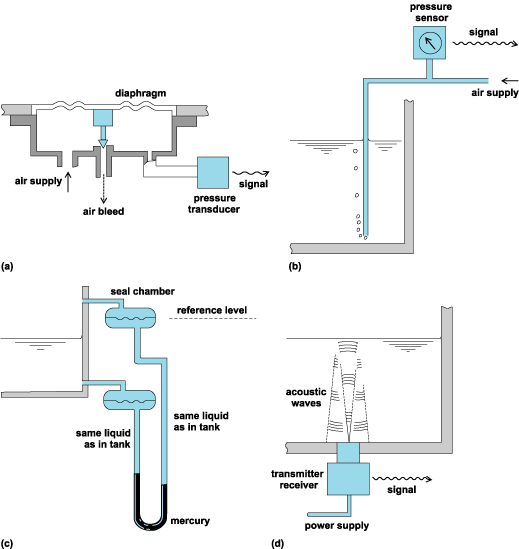The pressure p at any depth h in a liquid of density ρ is given by the following equation, p = ρgh, where g is acceleration due to gravity. Hence, if the density of liquid is known, the depth of liquid above a selected point can be determined by measuring the pressure in the liquid at that point.
Pressure gauge:
In an application with a simple pressure gauge, it may be calibrated to give a direct reading of the depth of liquid. If the tank is closed and there is pressure in the space above the liquid surface, the difference in pressure between this space and the measuring point must be used.
Pressure diaphragm:
In applications where the liquid may be contaminated with aggressive impurities or contain solids or sludge, pressure gauges or their pressure-measuring tappings may become blocked and unresponsive. In such cases, pressure diaphragms installed flush with the inside surface of the vessel may be used. Movement of the diaphragm against a spring may be measured directly to give an indication of the pressure or depth of liquid.
However, since such movement is limited, it is better to apply a corresponding pressure to the back of the diaphragm so as to restore the diaphragm to its neutral position. Measurement of this external pressure then can be converted into a measure of the depth of liquid (Fig. 2a).
Fig. 2 Hydrostatic pressure and acoustic-wave measurements. (a) Pressure diaphragm. (b) Bubble tube. (c) Manometer. (d) Acoustic.
Bubble tube:
In order to discharge gas from a pipe or vessel into a liquid at some depth, the pressure of the gas must be at least equal to that of the liquid at that depth. Hence the depth of liquid at the point of discharge can be determined from the gas pressure, provided the gas flow rate is low enough to eliminate dynamic or frictional effects.
A pipe supplied with a steady but low flow of gas (such as air) may be inserted into a tank of liquid and the gas pressure in the pipe measured. This pressure measurement can then be converted into a measurement of the depth of liquid above the point of discharge (Fig. 2b).
Manometer:
A manometer may be used instead of a pressure gauge for measuring pressure (more correctly pressure difference). A manometer using mercury as the reference liquid reduces the level variation by a factor of about 13, making direct measurement more convenient, and is more sensitive than a pressure gauge.
Its location relative to that of the vessel in which the liquid level is being measured usually necessitates twin pipes from each side of the manometer extending back to the measuring points and filled with the same liquid as in the vessel (Fig. 2c).
